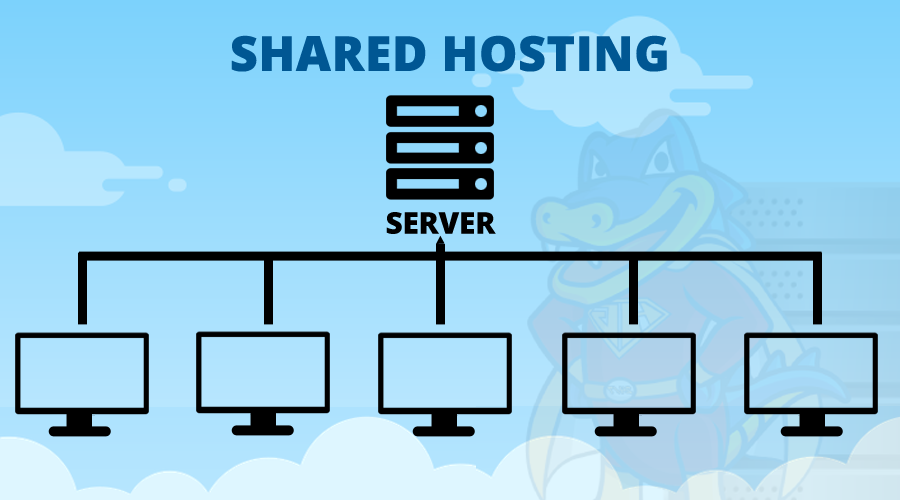Shared server hosting is a popular and cost-effective way to host websites and applications. In this model, multiple websites share the resources of a single server, including processing power, memory, and storage. This approach allows hosting providers to offer affordable plans, making it an attractive option for individuals and small businesses.
The shared environment offers a balance of affordability and accessibility, making it ideal for websites with moderate traffic and resource requirements. However, it’s crucial to understand the limitations and potential drawbacks of shared hosting before making a decision. This guide delves into the intricacies of shared server hosting, exploring its advantages, disadvantages, and best practices for maximizing its benefits.
What is Shared Server Hosting?
Shared server hosting is a type of web hosting where multiple websites share the resources of a single physical server. This means that your website shares the server’s processing power, memory, and storage space with other websites.
Shared Resources
Shared hosting is a cost-effective solution for small businesses and individuals who don’t need the resources of a dedicated server. It’s a good option for websites that don’t receive a lot of traffic and don’t require a high level of performance. However, it’s important to be aware that sharing resources with other websites can impact your website’s performance. If other websites on the server experience high traffic or resource demands, your website may also experience slow loading times or other issues.
Infrastructure of a Shared Hosting Environment
A shared hosting environment typically consists of a physical server that is divided into multiple virtual environments. Each virtual environment represents a separate website. The server’s resources are shared between these virtual environments.
“In a shared hosting environment, multiple websites share the same server resources, such as CPU, RAM, and storage.”
Use Cases for Shared Server Hosting
Shared server hosting is a popular choice for many websites and applications, particularly those with lower traffic and resource demands. It offers a cost-effective solution for getting your website online without needing to invest in expensive hardware or manage complex infrastructure.
Websites and Applications Suitable for Shared Hosting
Shared hosting is an ideal option for various websites and applications, especially those with lower traffic and resource demands. Here are some examples:
- Personal Blogs and Websites: Shared hosting is perfect for personal blogs and websites that don’t experience heavy traffic or require extensive resources. The cost-effectiveness of shared hosting makes it an attractive option for individuals and hobbyists.
- Small Business Websites: Small businesses with basic websites that showcase their products or services and handle simple online transactions can benefit from shared hosting’s affordability and ease of use.
- Portfolio Websites: Designers, photographers, and other professionals can create portfolio websites on shared hosting to showcase their work to potential clients. The shared hosting environment provides a stable platform for displaying their content effectively.
- Non-profit Organizations: Non-profit organizations with informational websites and online fundraising campaigns can utilize shared hosting to maintain a presence online without high costs.
- Static Websites: Websites with minimal dynamic content and rely primarily on static HTML pages, such as informational or landing pages, are well-suited for shared hosting. The lower resource demands of static websites make them ideal for the shared environment.
Requirements for Shared Hosting
Shared hosting is suitable for websites and applications with the following characteristics:
- Low Traffic Volume: Websites with a small number of visitors and minimal bandwidth usage are ideal for shared hosting. The shared environment can handle the traffic without impacting performance significantly.
- Limited Resource Demands: Websites with basic functionalities and minimal resource requirements, such as CPU, RAM, and storage, are well-suited for shared hosting. The shared environment provides sufficient resources for these applications to run smoothly.
- Simple Applications: Websites and applications with simple functionalities and limited database interactions can be hosted effectively on shared servers. The shared environment can accommodate the basic requirements of these applications.
- Cost-Effectiveness: Shared hosting offers a cost-effective solution for websites with low traffic and resource demands. The shared environment allows multiple websites to share resources, reducing the overall cost for each individual website.
Comparison with Other Hosting Models
Here is a table comparing shared hosting with other hosting models, highlighting their suitability for different use cases:
| Hosting Model | Traffic Volume | Resource Demands | Cost | Control | Suitability |
|---|---|---|---|---|---|
| Shared Hosting | Low | Low | Low | Limited | Personal websites, blogs, small business websites, static websites |
| VPS Hosting | Medium | Medium | Medium | Moderate | E-commerce websites, high-traffic blogs, community forums, small to medium businesses |
| Dedicated Hosting | High | High | High | Complete | Large enterprises, high-traffic websites, resource-intensive applications, sensitive data |
Choosing a Shared Hosting Provider

Choosing the right shared hosting provider is crucial for the success of your website. It’s not just about finding the cheapest option; you need to consider factors that ensure reliability, performance, and excellent customer support. This will guarantee a smooth and efficient experience for you and your website visitors.
Key Factors to Consider, Shared server hosting
Choosing a shared hosting provider requires careful consideration of various factors. These factors directly influence the performance, reliability, and overall experience of your website.
- Reliability: Reliability is paramount when choosing a shared hosting provider. You need a provider that ensures your website is consistently available and accessible to visitors. This means looking for a provider with a proven track record of uptime, minimal downtime, and robust infrastructure. Look for providers with a 99.9% uptime guarantee or higher, as this demonstrates their commitment to reliable service.
- Performance: Website performance is crucial for user experience. A slow-loading website can lead to frustrated visitors and ultimately, lost business. Consider the server’s processing power, storage capacity, and network bandwidth. Look for providers that offer SSD storage, which is significantly faster than traditional HDD storage. Ensure the provider has a strong network infrastructure with sufficient bandwidth to handle traffic spikes.
- Customer Support: Reliable customer support is essential, especially when encountering technical issues or needing assistance. Look for providers that offer 24/7 support through various channels, such as live chat, phone, and email. Consider the provider’s response time and their ability to resolve issues effectively. Read reviews and testimonials from other users to gauge the quality of customer support.
Essential Features and Considerations
Choosing a shared hosting provider requires evaluating a range of features and considerations to ensure a suitable fit for your website’s needs.
- Control Panel: A user-friendly control panel simplifies managing your website. Look for providers that offer popular control panels like cPanel or Plesk. These panels provide an intuitive interface for tasks such as creating email accounts, managing databases, and installing applications.
- Security Features: Security is crucial to protect your website and user data. Look for providers that offer features such as SSL certificates, firewalls, and malware scanning. These features help prevent unauthorized access and protect your website from attacks.
- Scalability: As your website grows, you might need more resources. Consider the provider’s scalability options. Can you easily upgrade your plan to accommodate increased traffic and storage needs? Look for providers that offer flexible plans and allow for seamless upgrades.
- Pricing and Plans: Compare pricing and plans from different providers. Consider your budget and the features offered. Look for value-for-money options that align with your website’s needs. Beware of overly cheap plans, as they often come with limited resources and support.
- Backups: Regular backups are essential to protect your website data from accidental deletion or data loss. Look for providers that offer automated backups, allowing you to restore your website to a previous state if needed. Ensure the backup frequency and retention policy meet your requirements.
- Technical Support: Look for providers that offer comprehensive technical support, including documentation, tutorials, and a knowledgeable support team. This ensures you have the necessary assistance to manage your website and resolve any issues that arise.
- User Reviews and Testimonials: Read reviews and testimonials from other users to gain insights into the provider’s performance, reliability, and customer support. Look for consistent positive feedback and consider the overall experience shared by other users.
Managing a Shared Hosting Account
Managing a shared hosting account involves performing various tasks to ensure your website runs smoothly and securely. This includes managing files, installing software, configuring databases, and monitoring your website’s performance.
Tools and Interfaces
Shared hosting providers typically offer a range of tools and interfaces to manage your account. These may include:
- Control Panel: A web-based interface that provides access to various account management features. Popular control panels include cPanel, Plesk, and DirectAdmin. These panels usually provide a graphical user interface for tasks like managing files, installing software, configuring databases, and managing email accounts.
- File Manager: A tool that allows you to upload, download, edit, and delete files on your website. Most control panels include built-in file managers. You can also use FTP clients like Filezilla to manage files.
- Database Management Tools: Tools for managing databases, including creating, deleting, and modifying tables, as well as importing and exporting data. Common tools include phpMyAdmin and MySQL Workbench.
- Command Line Interface (CLI): A text-based interface that provides more advanced control over your server. You can use the CLI to execute commands, install software, and manage files. SSH is a popular protocol used for accessing the CLI.
Common Management Tasks
- Installing Software: Most shared hosting providers offer one-click installers for popular software like WordPress, Joomla, and Drupal. You can also manually install software using package managers like Composer or by uploading files and configuring them manually. This process usually involves selecting the desired software from a list, providing necessary information, and confirming the installation.
- Managing Files: This involves uploading, downloading, editing, and deleting files on your website. You can use the file manager provided by your control panel or an FTP client. You can also access files via the command line using the SFTP protocol.
- Configuring Databases: Databases store information for your website. This involves creating databases, users, and tables. You can use database management tools like phpMyAdmin to manage your databases. You can also use the command line interface to manage databases.
- Monitoring Website Performance: Regularly monitoring your website’s performance is crucial to identify and resolve any issues. Most hosting providers offer tools for monitoring website traffic, uptime, and resource usage. You can also use third-party tools like Google Analytics to monitor your website’s performance.
- Managing Email Accounts: Shared hosting accounts typically include email accounts. You can create, delete, and manage email accounts through your control panel. You can also configure email settings like spam filters and autoresponders.
- Security: Ensuring your website’s security is paramount. This includes regularly updating software, using strong passwords, and implementing security measures like SSL certificates. You can also use security plugins and tools to enhance your website’s security.
Security Considerations in Shared Hosting: Shared Server Hosting
In the shared hosting environment, where multiple websites reside on a single server, website security becomes paramount. A breach in one website can potentially affect others, making it crucial to implement robust security measures to safeguard your website and data.
Common Security Threats and Vulnerabilities
Shared hosting environments are susceptible to various security threats and vulnerabilities, requiring proactive measures to mitigate risks.
- Cross-Site Scripting (XSS): This vulnerability allows attackers to inject malicious scripts into a website, compromising user data and potentially gaining control over the website.
- SQL Injection: Attackers exploit vulnerabilities in database queries to gain unauthorized access to sensitive data or manipulate database operations.
- Denial-of-Service (DoS) Attacks: These attacks aim to overload a server with traffic, making it unavailable to legitimate users.
- Brute-Force Attacks: Attackers try numerous password combinations to gain access to accounts.
- Malware Infections: Malicious software can be installed on websites, compromising security and potentially spreading to other websites on the shared server.
- Unsecured Configurations: Misconfigured software or weak security settings can create vulnerabilities for attackers to exploit.
Best Practices for Securing Websites and Applications
Implementing these best practices can significantly enhance the security of websites and applications hosted on shared servers:
- Keep Software Up-to-Date: Regularly update software, including operating systems, web servers, and applications, to patch vulnerabilities.
- Use Strong Passwords: Employ complex and unique passwords for all accounts and avoid reusing passwords across different platforms.
- Enable Two-Factor Authentication (2FA): Add an extra layer of security by requiring a second authentication factor, such as a code sent to a mobile device.
- Install a Web Application Firewall (WAF): WAFs act as a shield, filtering malicious traffic and protecting against common attacks like XSS and SQL injection.
- Regularly Back Up Your Website: Backups allow you to restore your website in case of data loss or security breaches.
- Monitor Website Activity: Regularly monitor website logs and traffic patterns to detect suspicious activity and potential security threats.
- Choose a Reputable Hosting Provider: Select a provider with a strong security track record, offering features like firewalls, intrusion detection systems, and regular security audits.
Performance Optimization in Shared Hosting
Shared hosting, while cost-effective, can present challenges in terms of website performance. Factors like resource contention, server load, and shared infrastructure can impact the speed and responsiveness of your website. However, with careful optimization, you can enhance performance within the limitations of shared hosting.
Factors Affecting Website Performance
Several factors can contribute to slow website performance in shared hosting:
- Resource Contention: When multiple websites share the same server resources, such as CPU, RAM, and bandwidth, competition for these resources can arise. This contention can lead to slow loading times and sluggish performance.
- Server Load: High server load, caused by a large number of simultaneous requests or resource-intensive processes, can also impact website performance. In a shared environment, if one website experiences a surge in traffic, it can affect the performance of other websites on the same server.
- Shared Infrastructure: Shared hosting environments typically have a single server hosting multiple websites. This shared infrastructure can lead to performance bottlenecks if one website consumes a disproportionate amount of resources, affecting the performance of others.
- Website Complexity: Websites with complex code, large files, and numerous external resources can also contribute to slow loading times. In shared hosting, these factors can amplify performance issues, as the server has limited resources to handle them.
Optimization Strategies
- Optimize Website Code: Efficiently written code can significantly improve website performance. This includes minimizing HTTP requests, reducing file sizes, and using caching techniques to store frequently accessed data. For example, minifying CSS and JavaScript files can reduce file sizes and improve loading times.
- Optimize Images: Images are often the largest files on a website, so optimizing them is crucial. Compressing images without compromising quality can significantly reduce file sizes and improve loading times. Using formats like WebP, which offer better compression ratios than JPEG, can further enhance performance.
- Use a Content Delivery Network (CDN): A CDN distributes website content across multiple servers worldwide, bringing content closer to users and reducing loading times. This is particularly beneficial for websites with a global audience. CDNs can cache static content, such as images, CSS, and JavaScript, further improving performance.
- Leverage Caching: Caching mechanisms store frequently accessed data, reducing the need for repeated requests to the server. This can significantly improve website performance, especially for dynamic content. Shared hosting providers often offer caching features, such as browser caching, server-side caching, and object caching, which can be leveraged to optimize performance.
- Monitor and Analyze Website Performance: Regularly monitoring website performance is essential to identify bottlenecks and areas for improvement. Tools like Google Analytics and PageSpeed Insights can provide valuable insights into website performance metrics, such as loading times, page size, and resource utilization. Analyzing these metrics can help identify areas for optimization and prioritize efforts.
Performance Optimization Checklist
- Analyze Website Performance: Use tools like Google Analytics and PageSpeed Insights to identify areas for improvement. This includes analyzing loading times, page size, resource utilization, and other relevant metrics.
- Optimize Website Code: Minify CSS and JavaScript files, compress HTML, and use efficient code structures to reduce file sizes and improve loading times.
- Optimize Images: Compress images without compromising quality, use appropriate image formats (e.g., WebP), and consider using lazy loading to defer image loading until they are visible in the viewport.
- Implement Caching: Utilize browser caching, server-side caching, and object caching to reduce server load and improve website responsiveness.
- Use a CDN: Consider using a CDN to distribute website content across multiple servers, reducing loading times for users worldwide.
- Monitor Website Performance: Regularly monitor website performance to track progress and identify any new bottlenecks or areas for optimization.
Closing Notes
Shared server hosting presents a compelling option for website owners seeking a balance between cost and functionality. While it offers advantages like affordability and ease of use, it’s essential to carefully consider its limitations, particularly regarding performance and security. By understanding the intricacies of shared hosting and implementing best practices, website owners can leverage its benefits while mitigating potential drawbacks. Choosing a reputable hosting provider with a strong track record of reliability and support is crucial for ensuring a smooth and successful hosting experience.




